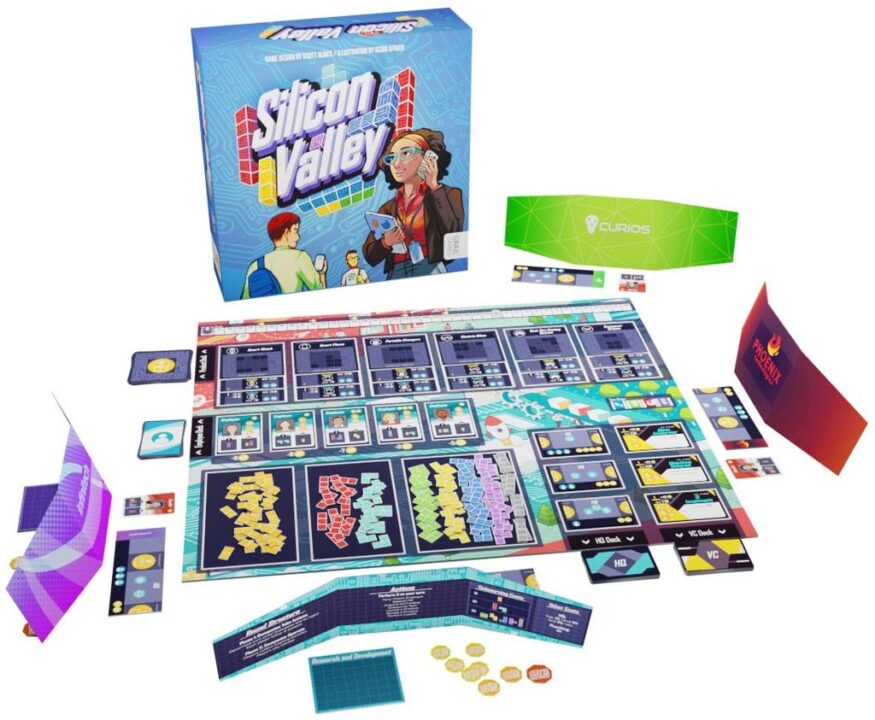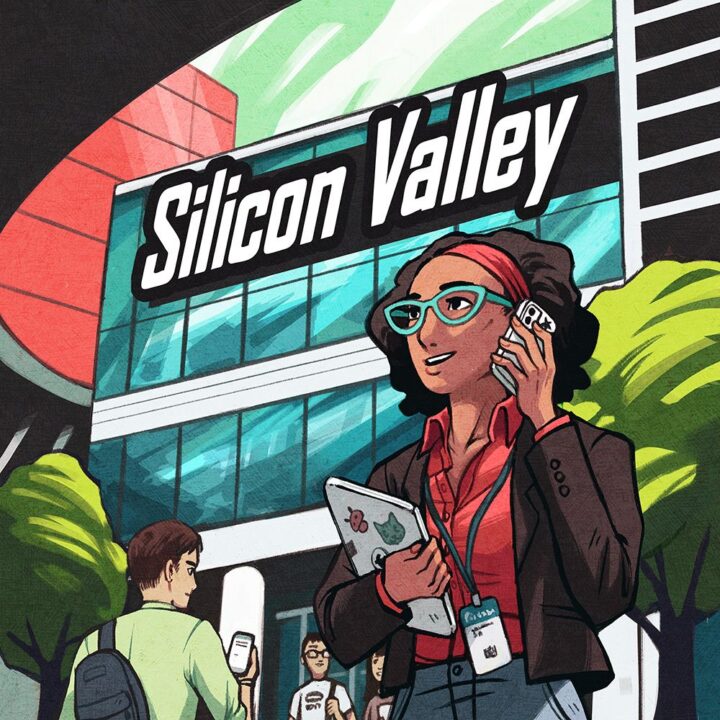Hey folks! Strap in, cause today we’re taking a wild ride through the world of tech startups in this review of Silicon Valley. Picture this: you and your friends are thrust into the crazy, fast-paced world of Silicon Valley, vying for that sweet spot at the top of the tech food chain. Does it sound thrilling? Well, it sure is! But does this game stand up to the test of playtime? Let’s break it all down, from game rules and flow, to player interaction, balance, component quality, and replay value. Will Silicon Valley be the next unicorn in your board game collection, or will it crash and burn faster than an overhyped app? Let’s find out!
How It Plays
Setting up
First, pick your favorite techie role: Developer, CEO, or that guy who brings coffee. Each role has unique skills. Lay out the board, and place the market tiles in the center. Everyone grabs a startup card, a small pile of seed money, and a few tech cards. You’re ready to rock and roll!
Gameplay
The game unfolds in phases: Idea Phase, Development Phase, and Market Phase. In the Idea Phase, brainstorm ideas by drawing cards. The Development Phase is all about building; spend your resources wisely to develop groundbreaking tech. Finally, the Market Phase introduces your creation to the world. Flip market tiles, face events, and try to outshine competitors. Keep an eye out for those venture capitalists; they can make or break your startup.
Winning the game
Victory goes to the player who earns the most profit by the end of the game. That’s right, it’s all about the dough. But beware, there’s more than one way to earn it. Innovate, secure investments, and navigate market crashes. With a bit of luck and a lot of skill, you’ll dominate Silicon Valley!
Want to know more? Read our extensive strategy guide for Silicon Valley.
Game Rules and Flow: Silicon Valley
Silicon Valley is a board game that captures the thrill and chaos of the tech industry. It’s like being in a startup, minus the free snacks and bean bags. The game starts with each player picking a tech company role, such as CEO, Developer, or Investor. Each role has unique abilities, which makes the game more interesting.
The objective? Simple! Be the first to build a unicorn company valued at $1 billion. But here’s the twist, folks: the journey to that billion-dollar valuation is like navigating a minefield while riding a unicycle. The game board acts as your company’s roadmap, filled with projects, events, and dreaded setbacks.
The game runs in rounds, each consisting of three phases: Planning, Execution, and Review. During the Planning phase, you draft project cards (think product launches, partnerships, or even hiring sprees). The Execution phase is where dice come into play. Roll the dice to complete your projects, but beware—random events can throw you off track. Finally, the Review phase is where you manage resources and evaluate your progress.
The dice rolling introduces an element of luck, but strategy still plays a huge role. You must balance speed with caution, as pushing too hard can backfire. Each decision feels weighty, and a single misstep can cost you the game.
The rules are extensive but well-organized, making for a smooth learning curve. Yet, if you despise luck-based mechanics, this game might grind your gears a bit.
Next up, let’s open the treasure chest that is Player interaction and balance. Spoiler alert: this game can make or break friendships!

Player Interaction and Balance in Silicon Valley
If you love a game where players must go head-to-head in a cutthroat environment, Silicon Valley hits the mark. This game simulates the intense competition where each move can make or break your startup. You and your fellow players will be CEOs, navigating the turbulent tech industry. Every decision you make influences not only your fate but also that of your competitors.
One of the standout features of Silicon Valley is how it handles player interaction. You’ll find yourself negotiating deals, acquiring resources, or even sabotaging other players’ projects. This dynamic interaction keeps everyone on their toes. No one can just sit back and ride the wave—active engagement is mandatory. You want to acquire that crucial piece of technology before your buddy does? Be faster, smarter, and a bit ruthless!
Balance in Silicon Valley is surprisingly well-crafted. The designers made sure nobody could easily steamroll through the game. It offers a blend of strategy and luck that feels just right. You can’t rely solely on your planning skills; luck plays a role, but it’s not the be-all and end-all. This balance ensures no one gets left in the dust too quickly. Just when you think you have it all figured out, an unexpected event can throw a wrench into your plans, keeping the game exciting and unpredictable.
Next up, we’ll check out the component quality and design, but let me tell you, it’s a feast for the eyes!
Component Quality and Design: Silicon Valley
Ah, Silicon Valley! This game doesn’t just look good; it feels good too. The component quality is top-notch. The board is sturdy, and the artwork is vibrant. You can feel the attention to detail. The cards are thick and durable, which is always a big plus. You won’t worry about spills ruining your game night.
The tokens and pieces don’t disappoint either. They are well-crafted and add a tactile pleasure to the gameplay. The colorful, techy design theme really immerses you in the world of startups and venture capitalists. The icons and symbols are easy to understand, reducing the downtime spent figuring out what everything means. Kudos to the design team for that!
One of my favorite parts is the player screens. They look like little laptops! It’s a small touch, but it adds a whole lot of charm. They also help keep your strategy secret, adding an element of intrigue and surprise. Who knew that cardboard could be this exciting?
Now, it’s not all sunshine and rainbows. Some components, like the player boards, could have been a bit bigger. They tend to get crowded, especially in the heat of action. But hey, nothing’s perfect, right?
Overall, the component quality and design make Silicon Valley a joy to play and look at. Next up, let’s chat about how often you’ll actually want to dive back into this techy world with our discussion on replay value and variability.
Replay Value and Variability in Silicon Valley
Now, let’s talk about why Silicon Valley keeps sneaking back to our game nights. I mean, who doesn’t love a game that never gets old? The key here is replay value and variability.
Silicon Valley shines bright in these areas. First off, each game feels fresh because of its dynamic setup. The game offers different company start-ups and a variety of tech gadgets. You never know what you’ll get, making each session unique. It’s like a tech carnival every time!
The role cards add another layer of excitement. From the cutthroat CEO to the ingenious developer, the roles change dramatically each game. And trust me, I’ve seen it all – my buddy Dave once played as the CFO, and he managed to bankrupt us all. It was both hilarious and frustrating!
Then we have the project cards. These projects vary in difficulty and reward. They keep you on your toes, strategizing your next move. The projects can either make or break your game plan, so choose wisely.
And let’s not forget the unpredictability of the market phase. The market conditions change with each round, affecting your strategies. It’s like dancing on a bed of hot coals – one misstep and you’re toast!
If you enjoy games that keep surprising you with each playthrough, Silicon Valley is right up your alley. Its high replay value and variability ensure no two games feel the same. So, do I recommend it? Absolutely! This game is a winner in my books.
Conclusion
So, there you have it, folks. Silicon Valley packs a punch with its strategic depth, immersive components, and dynamic replayability. While it has minor crowding issues on the player boards and a hint of luck in the market phases, it keeps you on your toes with its balance and player interaction. It’s not perfect, but if you’re a fan of competitive, strategy-heavy games, this one’s a keeper! Thanks for joining me on this rollercoaster ride through Silicon Valley. Until next time, happy gaming!


